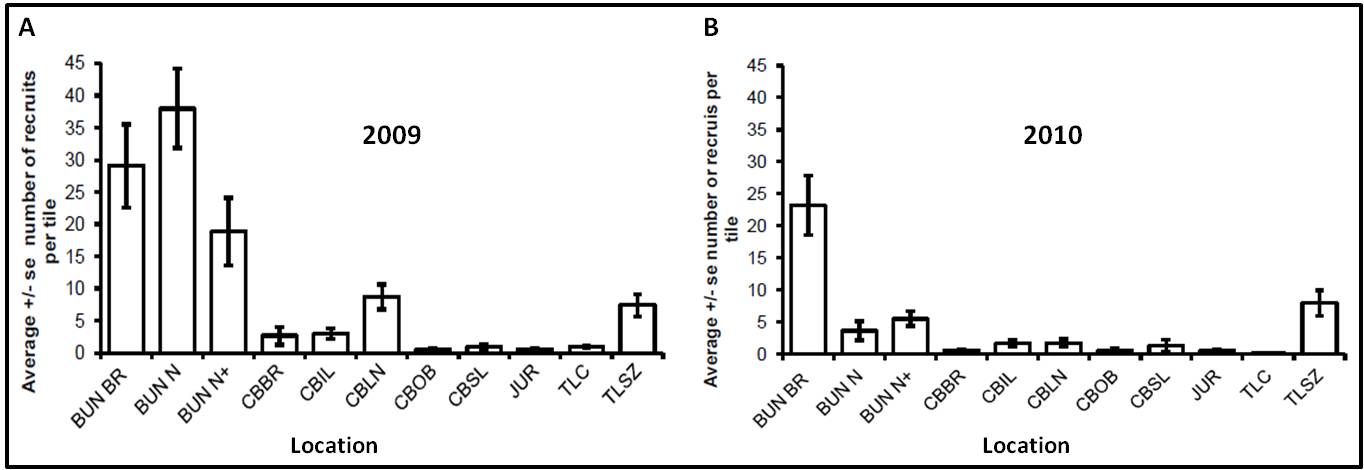Home > Browse by Themes > Biodiversity > Coral recruitment in the Ningaloo Marine Park
Coral recruitment in the Ningaloo Marine Park
- Australian Institute of Marine Science
- Australian Institute of Marine Science
Recruitment is the measure of the number of young individuals (i.e. coral larvae in the case of corals) entering the adult population. Studies of coral recruitment are important as reef scientists and managers become more aware of the importance of monitoring processes such as recruitment rather than just changes in adult abundance in order to understand how reef ecosystems function. Furthermore, early stages in the life history of corals are often more susceptible to certain environmental perturbations (such as nutrients and sediments) than adults. As such, measuring changes in patterns of coral recruitment can provide an early warning of potential changes in reef resilience.
Given the importance of coral recruitment, as part of a project under WAMSI 3.1.2, the abundance of newly settled corals following the 2009 and 2010 annual coral spawning peaks (March to May) was measured in the northern half of the Ningaloo Marine Park (NMP) at 11 locations (1 to 9 m depth) - 3 at Bundegi, 3 at Tantabiddi, and 5 at Coral Bay (see Google Earth layer below). Eighteen terracotta tiles (110 x 110 x 10 mm) per location (6 tiles x 3 sites) were attached to the reef substrate on stainless steel plates – representing a total of 198 tiles in 2009 and 198 tiles in 2010. Identical fixture sites were used for both the 2009 and 2010 samples.
There was a 58% reduction in settled recruits on the tiles between 2009 and 2010 (1999 recruits in 2009; 841 recruits in 2010). While the Pocillopora, Porites, and Isopora recruits were similar between the two sample years, there was a pronounced decrease in settled Acropora in 2010 compared to 2009 (Table 1). The large drop in Acropora settlement results may reflect normal inter-annual variation in larval output, reduced larval production by the Acroporidae due to some selective stress effect during the preceding year, or a sampling artefact.
Table 1. Taxonomic breakdown of corals settled on tiles in the Ningaloo Marine Park. |
|||||
| Acropora | Pocillopora | Porites | Isopora | Other | |
| 2009 | 57.3% | 5.4% | 2.5% | 0.05% | 34.7% |
| 2010 | 8.8% | 5.4% | 2.5% | 0.05% | 85.3% |
In addition to the temporal differences in settlement on the tiles, differences in settlement occurred across the 11 sample locations, with Bundegi consistently having the highest settlement success despite the drop in 2010 numbers (Figure 1; see Google Earth layer below). The greater settlement variability across large spatial scales as opposed to within locations suggests that recruits are being drawn from stocks of spawning corals at a larger scale than the immediate vicinity of the recruitment tiles, but this relationship is not well established for Ningaloo.
In order to realise the full potential of how coral recruitment patterns contribute to reef resilience and to understand the annual variability and long term trends of coral recruitment in the NMP, additional sample years are necessary.
For more detailed information on this study (including comparison of alternative methods for the census of juvenile corals), see Depczynski, M, Heyward A, Case M, Colquhoun J, O'Leary R, Radford B, Wilson S, Holmes T (2011), or contact the corresponding author, Dr Martial Depczynski.
Dataset details
| Custodian | Dr Martial Depczynski |
| Owner institution | Australian Institute of Marine Science (http://www.aims.gov.au/) |
| Spatial extent | Bundegi (21° 52' S, 114° 10' E) to Coral Bay (23° 08' S, 113° 46' E) |
| Data collection | 2009 and 2010 |
| Copyright | Copyright remains with the data owner(s) |
| Reference | Click here |








